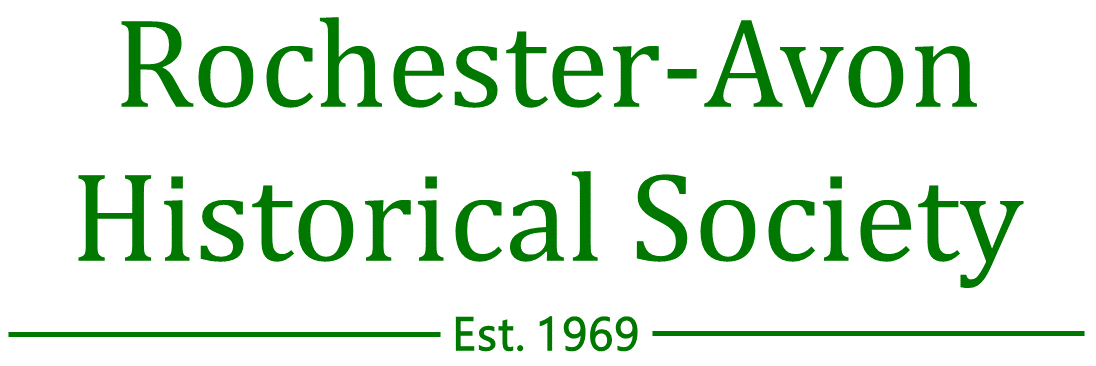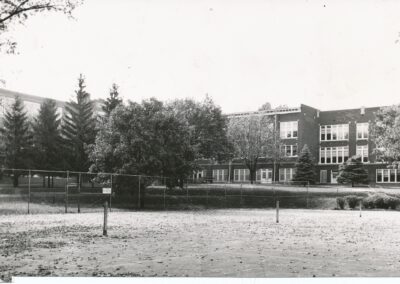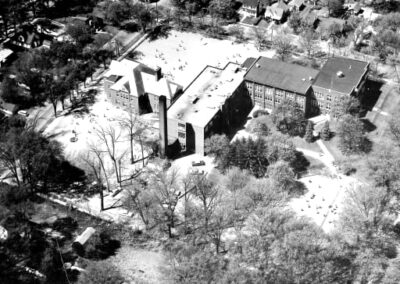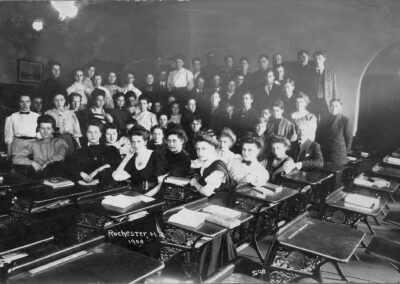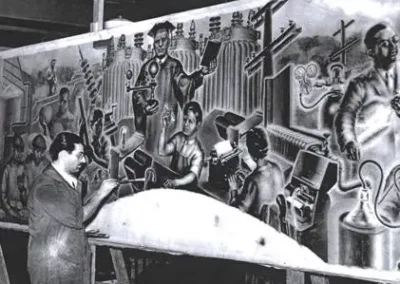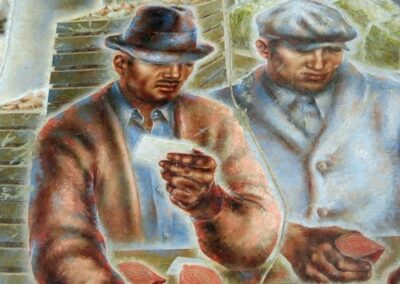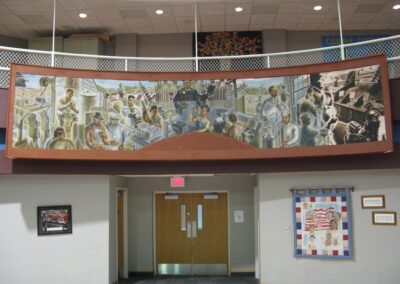Harrison School Complex
Consider making a financial donation
Your donation will help support our efforts to help save the former Harrison School and Rochester High School building. Thank you for your support.
Share Your Story
Please help us learn more about the former Rochester High School and Central Junior High School located at 501 W. University St., Rochester, MI. If you or a family member attended school in the educational complex through the early 1970s, we’d love to hear from you! To share your story, tap on the link button. We’d be honored to post the story in our Stories Behind the Names project on our website and social media platforms.
Join Us
To keep updated on the latest news about the former Harrison School and Rochester High School Building, consider joining our Facebook group dedicated to sharing stories and information about preserving this special building in downtown Rochester.
Historical Timeline
1847: A private academy was established at this site and operated for a decade.
1857: Academy acquired by Avon School District #5 and converted to a public school.
1888: The building was consumed in a presumed arson fire causing the school district to make plans for a new, fireproof structure.
1889: The oldest section of the complex is built to replace the frame building that burned.
1916: Due to overcrowding and a need for a high school, a new building is added to the complex. It stands adjacent the 1889 building on the corner of Wilcox and Fifth St. (now West University Drive) and allows the old building to be used exclusively for lower grades. The 1916 building was Rochester’s first dedicated high school building.
1920: An addition was made to the new high school.
1928-29: A new building to house the junior high grades was built between the high school and the 1889 building, physically connecting both structures and creating one large school campus.
1934: The old 1889 building was extensively remodeled at this time, and the school board voted to name it the William F. Harrison School in recognition of the man who had served as the school’s custodian since 1897. Harrison remained at his post as school custodian for a total of 45 years, until his death in 1942.
1957: A new high school campus opened at the corner of Walton and Livernois. Thereafter, the junior high grades expanded into the former high school. Central Junior High School occupied the building until 1973, when it was closed in favor of two new junior highs, Reuther and Van Hoosen.
1970s: The school building was repurposed to house the Rochester Community Schools administration offices.
2022: The RCS administrative staff began vacating 501 W. University Dr. for a new office located on Dequindre Rd.
In the News
November 10, 2025: The Harrison Community Center Group address the RCS Board of Education requesting placement on the Feb. 26, 2026, agenda for a presentation addressing the preservation of the building.
January 24, 2022: RAHS President Addresses Rochester City Council Over Resolution
Rochester Post Feb. 9, 2022: https://www.candgnews.com/news/rcs-accepting-proposals-for-historical-administration-building-property-122618
Oakland Press May 22, 2021: https://www.theoaklandpress.com/local-news/rochester-school-district-moving-out-of-historic-administration-building/article_1d1ff2a6-bb2c-11eb-a603-f3be7c218234.amp.html
Rochester Post May 26, 2021: https://www.candgnews.com/news/rcs-purchases-7-million-office-and-warehouse-facility-120746
HISTORY OF HARRISON SCHOOL BUILDING
The buildings that comprise the Rochester Community Schools Administration Complex were built as individual schools in 1889, 1916 and 1928, and were connected to create one large school campus. The site consists of the 1889 Harrison School building at the corner of Fourth and Wilcox Streets, the 1916 Rochester High School building at the corner of University Drive and Wilcox Street, and the 1928 building, which connects the 1889 and 1916 buildings. The site has been the location of a school building since 1847. The 1889 Harrison School building was placed on the Michigan Register of Historic Sites in 1987.
Click here to view our TheClio.com entry about the building.
n February 2022, the RAHS board of directors passed a resolution in favor of historically preserving the Administration Building located at 501 W. University Drive. Click here to view the resolution. This document is non-binding and is a statement from the historical society. It was sent to a number of local government entities and cultural organizations.
BEERBOHM MURAL
In late 1933 and early 1934, a Depression-era Civil Works Administration (CWA) project was used to renovate and redecorate the building.
Two art projects, a bas-relief mural by Leonard Jungwirth and a painted mural by Marvin Beerbohm, were also funded by Federal projects during this time.
The Beerbohm mural, which was covered up during a 1961 renovation of the building, was rediscovered during the 1989-90 renovation of the building. It was seriously damaged, but was restored in 2011 through the efforts of the Rochester-Avon Historical Society and was hung in the former gymnasium until 2023-24 when the mural was relocated to the RCS Administration’s new office building on Letica Dr.
The Mural's Restoration
From the 2011 Rochester Patch article by Tiffany Dziurman:
Dozens of art enthusiasts, community leaders and volunteers gathered Friday night in the Harrison Room of the Rochester Community School’s Administration Center for the unveiling of Marvin Beerbohm’s restored 1938 mural, “Industrial Environment of Rochester High School.”
Sounds of 1930s music filled the room as guests, anticipating the mural presentation, enjoyed tasting dozens of wines selected by Cose dí Lusso and hors d’oeuvres from local food markets.
The event was sponsored by the Rochester-Avon Historical Society, the Rochester Historical Commission and Rochester Community Schools. The artist’s daughter, Cynthia Beerbohm Maguire of Pentwater, was the evening’s guest of honor.
Standing near a table filled with tools and materials used to move and clean the painting, LaVere Webster, a historical society member and accomplished art conservator who oversaw the mural’s restoration, told the audience what works of art such as the mural mean to him.
“We need more random acts of culture,” he said. “A day without art is an empty soul.”
Webster explained how he and a team of volunteers worked for two years to move, clean and reaffix the mural to a new canvas.
“What is the mural’s value?” asked Webster. “Priceless.”
In a news release about the event, Webster called the mural Rochester’s most significant painting.
Maguire, who was born in 1940 and was unaware of the mural’s existence until she was contacted by the Rochester-Avon Historical Society last October, said she was thrilled to learn about the mural and the restoration effort.
“Art was my father’s life,” Maguire told the crowd as she shared stories of her father’s life and career.
She explained that her late mother, Regina, once a Ford Motor Co. employee, served as her father’s research assistant and learned about the significant people and places Beerbohm eventually painted into his murals.
“I feel both of their presences here tonight,” Maguire said, “and they are smiling.”
Maguire, who attended the unveiling with her husband, David, and her daughter, Holly Selden, thanked everyone who supported the mural’s restoration, saying that it “will illuminate Rochester’s rich past.”
The 23-foot-long by 57-inch-high mural was reinstalled on the balcony in the Harrison Room – a room that had been a gymnasium when the Administration Center building was the first Rochester High School.
Originally, the mural hung over the central stairwell in the former high school. A 1961 renovation project covered it, leaving the painting hidden for decades. In the early 1990s, during another round of renovations, work crews uncovered the mural – in pieces.
“The construction crew pulled off wall board and found pieces of the mural on the back of the board,” Rod Wilson, president of the Rochester-Avon Historical Society, which spearheaded the restoration project, told Rochester Patch last October. “Those pieces were put away for safekeeping for nearly 20 years.”
In 2007, Wilson’s wife, Susan, and a Rochester High School graduate who remembered the mural, asked her husband to take a look at it.
That one simple request turned into a two-year restoration effort backed by financial and in-kind donations from the historical society, the Rochester Historical Commission, Rochester Community Schools, National City Bank (now PNC) and local builders E. Gilbert & Sons Inc. The historical society estimates the project cost at more than $50,000.
Under Webster’s direction, the mural was painstakingly cut away from thick plaster (breaking five chain saws in the process) and put back together to be cleaned and restored. Large portions of the mural were missing. One piece was recovered, but two large sections have yet to be found.
To fill in the gaps, the historical society reprinted a photo of the mural found at the Smithsonian Archives of American Art in Washington, D.C.
The missing sections were reprinted to the exact measurements of the mural and in sepia tone so they were distinguishable from the rest of the painting. The historical society hopes to locate the missing segments.
In the early 1930s, President Franklin Roosevelt launched the Works Progress Administration as part of his New Deal initiatives to put people, including artists, to work during the Great Depression. Beerbohm, a Detroit artist, accepted commissions from the federal government to create murals in public spaces, such as schools and libraries, throughout the United States.
Beerbohm painted the Rochester High School mural in 1938 and incorporated themes important to Rochester and the high school at the time.
Among the painting’s subjects are the Ferry-Morse Seed Farm that once covered hundreds of acres along Rochester Road; the Parke-Davis Biological Farms, which produced vaccines, antitoxins and medicines; school Superintendent Abram L. Craft, who managed the school district from 1898 until 1908; and images of students conducting classroom work.
In June 1938, the Rochester Clarion reported: “School authorities agree that artist Marvin Beerbohm has handled his subject in a masterly way and regard the mural as a distinct cultural addition to the school. Teachers and pupils unite in praising the work, and in the last few days many townspeople have made special trips of inspection on the strength of their children’s recommendation.”
When asked about her father’s life as an artist, Maguire explained that he struggled for a time when murals and his style of painting went out of vogue in the 1950s.
“He floundered for a while to find a style that was commercial and could sell,” she said.
Maguire explained that during World War II, Beerbohm illustrated tank manuals. In the 1950s, he taught art classes on Saturdays to junior high and high school students at the Detroit Institute of Arts and to members of the YWCA in the 1960s.
Maguire first saw the mural on a visit to Rochester last December.
“I touched the painting, and it was like touching my father’s hand,” she said.
About the mural’s unveiling, Debra Hartman, director of community relations for Rochester Community Schools, said, “The Rochester-Avon Historical Society just presented a wonderful gift to the community. Without their passion and dedication, the project, I’m sure, wouldn’t have happened.”
With the restoration project now complete, Wilson gazed at the mural and reflected on the accomplishment.
“What a great gift the historical society has given back to the community,” he said. “This is what a historical society should be doing.”
